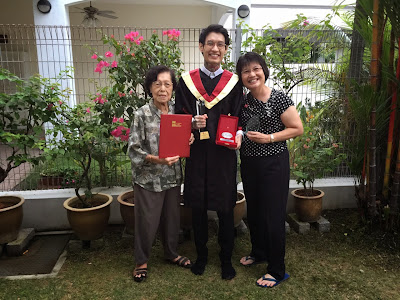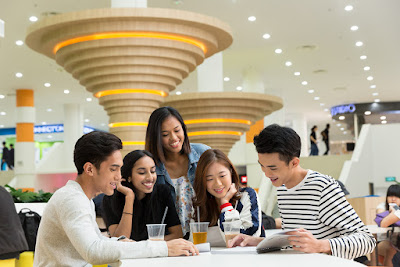It's no rocket science in Germany
Twenty-one students from the School of Chemical & Life Sciences had a blast in Germany learning how rockets were launched and even enjoyed some works of art. This was all thanks to a 10-day educational trip they took in September 2016.
This trip was planned to expose the students to the chemical industries and education systems in Germany. They were accompanied by lecturers Miss Irene Ng and Miss Cai Shiying.
Our students� first impressions were that Germany is a very eco-friendly country, with majority of the dustbins being recycle bins. Do you know that in Germany, people have to pay for the trash that they dispose? The more one recycles, the more money he or she can save.
 |
| Majority of Germany�s dustbins are recycle bins |
On the second day, the students visited the Berlitz School where they attended an intensive German Language course. This helped to remove communication the barriers between international students and Germans.
During the rest of the day, the group spent their time in the Mannheim city centre where they visited Wasserturm, a beautiful water tower, and enjoyed shopping at Paradeplatz.
On the third day of their tour, they visited Hochschule Mannheim, the University of Applied Sciences at the city of Mannheim.
Ms Annette Flach from the International Office gave an overview of Hochschule Mannheim as well as the admission criteria for international students. The university�s stringent requirement for its lecturers was highlighted. Not only do lecturers need to have a doctorate (PhD), they also need a minimum of five years of working experience in their respective industries. University students will have opportunities to work in various companies who are in partnership with the university.
Next, the university�s Dr Philipp Wiedemann introduced the students to the Biotechnology department and led the group on a tour around the laboratories. After that, the group was introduced to the Chemical Engineering department and brought to a virtual chemical plant where the students put on special glasses to view the plant.
 |
Virtual chemical plant |
BASF is the largest chemical producer in the world. The tour was conducted by Ms Katya Kostyana, a representative from the BASF visitor�s centre, who showcased BASF�s most innovative inventions and chemical applications at the Visitors Centre. It even has a huge display of the elements in the periodic table.
Periodic table containing actual chemical elements
At the visitor center, the students were introduced to a superabsorbent polymer that is used in diapers. How rockets are launched into the airspace was also explained in BASF. Who would have known that water, something we use every day, helps in the launch rockets. The students were really fascinated by the interactive display of the mini rocket, and they kept turning the knob on the display to generate electrical energy to split water into hydrogen and oxygen. When the quantity of gas produced is large enough, the gases react to form water in an explosive reaction, which provides sufficient energy to launch the rocket.
After touring the visitor center, the group was brought on a guided tour of the plant by bus. Everyone was deeply impressed by the sheer size of the site!
 |
| How an explosive reaction between hydrogen and oxygen can launch a mini rocket |
 |
| Application of superabsorbent polymer |
 |
| At a landfill |
 |
| Plant material that was converted to fertilizers |
 |
| Recycling bins for different types of glass in Abfallwirtschaft Mannheim |
 |
| Bahnstadt office building |
 |
| Bahnstadt housing for researchers |
Of all the places they visited, the students� favourite was the Technische Universit�t M�nchen (TUM). TUM is a state building in Germany. It is a requirement for state buildings to house a piece of art. Over at TUM, its art piece happened to be a giant slide from the fourth storey to the first floor. The NYP team enjoyed sliding down the slide tremendously. The tour of TUM was conducted by a TUM student who is pursuing her masters in Biochemistry. She brought the group around the campus and answered our queries.
 |
| The TUM slide that stretched 4 stories |
Allianz Arena
A football stadium in Munich, Bavaria, Germany with a 75,000 seat capacity.
Rothenburg ob der Tauber
A breathtaking medieval city where the group visited Christmas Museum and the K�the Wohlfahrt
Christmas Store.
Ayinger Brewery tour
A guided tour where a brewmaster explained how beer was made.
Marienplatz
The central square of Munich.
Schloss Neuschwanstein
A fairytale castle built by King Ludwig II of Bavaria, Germany.
Dengel Chocolate factory
Dachau concentration camp (now a memorial site)
 |
| Dachau bunk beds, where victims of Hitler regime slept |
 |
| Courtroom 600 of Nuremberg Trial |
Miss Cai Shiying, one of the lecturers who organised the trip, shared that she had been on a study trip to Germany when she was a student at NUS and hoped to create a similar and memorable experience for the SCL students. Thus she included a good balance of educational and cultural locations in the trip, including a visit to the Schloss Neuschwanstein castle, which she visited as a student.
As the NYP trip coincided with Oktoberfest in Germany, the students also had the opportunity to see people dress up in the traditional Bavarian costumes in the streets and experience the festive mood while having authentic Bavarian food.
For Malcom Hon (above) from the Diploma in Chemical & Pharmaceutical Technology, the industrial trip to the BASF was especially memorable as he had always wanted to learn how a chemical plant functioned. The history of BASF and its inventions had fascinated Malcom, so did the scale of operation in the chemical plant.
Said Clara Cheong (above) from the Diploma in Chemical & Pharmaceutical Technology: �I really enjoyed the cultural visit to the beautiful Schoss Neuschwanstein castle. Even with the fear of heights and the tedious climbing, the scenery I was rewarded with after all the hard work was worth it.�
By Christopher Teo Yu Yuan, Diploma in Medicinal Chemistry
A smile is a curve that sets things straight.
Never be afraid to try. Even if we fail, there is no better way to live. Continue to pursue to what you truly love to do.


















Comments
Post a Comment